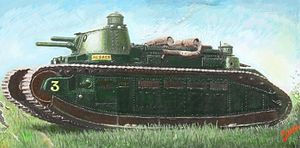Char 2C
| Char 2C | |
|---|---|

Char 2C Alsace
|
|
| Type | Heavy tank |
| Place of origin | France |
| Service history | |
| In service | 1921–1940 |
| Used by | France |
| Wars | World War II |
| Production history | |
| Designed | 1917 |
| Produced | 1921 |
| No. built | 10 |
| Variants | Char 2C bis |
| Specifications | |
| Weight | 69 tonnes (68 long tons; 76 short tons) |
| Length | 10.27 m (33 ft 8 in) |
| Width | 3 m (9 ft 10 in) |
| Height | 4.09 m (13 ft 5 in) |
| Crew | 12 |
|
|
|
| Armour | 45 mm (1.8 in) max. |
|
Main
armament |
75 mm Canon de 75 modèle 1897 |
|
Secondary
armament |
Four 8 mm Hotchkiss Mle 1914 machine guns (three in gimbal ball mounts at front and both sides forward, one mounted in a rear turret) |
| Engine | Two engines 2 x 250 hp |
| Suspension | unsprung |
|
Operational
range |
150 km (93 mi) |
| Speed | 15 km/h (9.3 mph) |
The Char 2C, also known as the FCM 2C, is a French heavy tank, later also seen as a super-heavy tank, developed during World War I but not deployed until after the war. It was, in physical dimensions, the largest operational tank ever made.
The origins of the Char 2C have always been shrouded in a certain mystery. In the summer of 1916, probably in July, General Léon Augustin Jean Marie Mourret, the Subsecretary of Artillery, verbally granted Forges et Chantiers de la Méditerranée (FCM), a shipyard in the south of France near Toulon, the contract for the development of a heavy tank, a char d'assaut de grand modèle. At the time, French industry was very active in lobbying for defence orders, using their connections with high-placed officials and officers to obtain commissions; development contracts could be very profitable even when not resulting in actual production, as they were fully paid for by the state. The French Army had no stated requirement for a heavy tank, and there was no official policy to procure one, so the decision seems to have been taken solely on his personal authority. The reason he later gave was that the British tanks then in development by a naval committee seemed to be better devised as regarded lay-out, ventilation and fire protection, so a shipyard might improve on existing French designs. Exact specifications, if they ever existed, have been lost. FCM then largely neglected the project, apart from reaping the financial benefits. At that time all tank projects were highly secret, and thereby shielded from public scrutiny.
On 15 September 1916 the British deployed tanks in battle for the first time in the form of the Mark I, and a veritable tank euphoria followed. When the public mood in Britain had been growing ever darker as the truth of the failure of the Somme Offensive could no longer be suppressed, tanks offered a new hope of final victory. The French people now became curious as to the state of their own national tank projects. French politicians, not having been over-involved in them and leaving the matter to the military, were no less inquisitive. This sudden attention greatly alarmed Mourret, who promptly investigated the progress that had been made at FCM and was shocked to find there was none. On 30 September he personally took control of the project. On 12 October, knowing that the Renault company had some months earlier made several proposals to build a heavy tracked mortar which had been rejected, he begged Louis Renault to assist FCM in the development of a suitable heavy vehicle; this request Renault obliged. Even before knowing what the exact nature of the project would be, on 20 October Mourret ordered one prototype to be built by FCM.
...
Wikipedia
